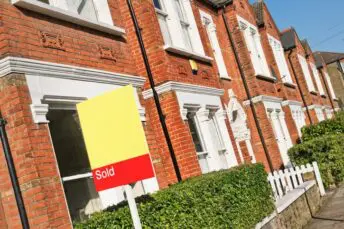House Price Watch May 2023
The housing market continues to experience a readjustment in house prices with annual house price growth falling for the first time in ten years and transactions at a ten year low (excepting the Covid period). Following tentative signs of the market stabilising, new headwinds have emerged as a result of stubbornly high inflation figures. With the Bank Rate up, fixed mortgage rates have started rising again, putting renewed pressure on buyer and seller confidence. As a result, further downward pressure on house prices and transactions is still expected.
What’s happening nationally
House prices are up on average +0.1% in the past month and down on average -0.3% in the past year — the first annual fall in house prices in a decade.
The indices are showing a range of house price movements over the past month. Rightmove and Land Registry are showing a rise, Halifax is seeing stable house prices and Nationwide is reporting a fall in house prices over the past month. All the indices note a slowing of the annual rate of growth with Nationwide and Halifax reporting a fall in house prices over the past year.
Indices based on:
Land Registry – registered property transactions in April.
Nationwide & Halifax – mortgage valuations in May.
Rightmove – asking prices posted on Rightmove in May.
*Rightmove is not included in the index average as the basis for its index is different (asking price vs agreed sale price)
| Index reports: | Monthly change | Annual change |
|---|---|---|
| Land registry | +0.5% | +3.5% |
| Nationwide | -0.1% | -3.4% |
| Halifax | 0% | -1.0% |
| Rightmove | +1.8% | +1.5% |
| Average change | +0.1% | -0.3% |
House prices in your area
Most areas experienced a rise in house prices compared with last month, although the rate of annual house price growth continues to slow across the country.
Average house prices are highest in London (£534K) and lowest in the North East (£159K).
House price growth varies somewhat by property type. Detached (+4.2%), semi detached (+4.5%), terraced (+2.1%) and flats/ maisonettes (+2.7%) according to April Land Registry data.
| UK Region | Average price £ | Monthly change | Annual change |
|---|---|---|---|
| England | |||
| Nothern Ireland | |||
| Scotland | |||
| Wales | |||
| North West | |||
| Yorkshire and The Humber | |||
| North East | |||
| West Midlands | |||
| East Midlands | |||
| South West | |||
| East of England | |||
| South East | |||
| London |
| UK City | Average price | Annual change |
|---|---|---|
Market Monitor
There were 82K transactions in April, down 8% on March 2023 and 25% lower than April 2022. 82K transactions is the lowest transaction level seen in 10 years (other than the initial Covid period in 2020).
Demand continues to fall but new instructions from sellers are up this month. Average stock per agent is up slightly month on month.
Time to sell is steady at approximately 55 days, slower than the average of 42 days over the last 12 months.
How busy is the market?
- Not busy
- Normal
- Very busy
- Transactions down in April, ten year low (apart from Covid 2020)
- Total transactions in April 82K
- -8% from last month
- -25% from April last year
Homes for sale vs homebuyers
- Good availability of homes
- Normal
- Shortage of homes
- Buyer enquiries continue to fall(-18% RICS); thirteenth monthly drop
- Seller enquiries up (+14% RICS)
- Average stock per agent 47; up from 45 last month (incl under offer/ Sold STC Rightmove)
Average speed of sale
- Fast
- Normal
- Slow
- 55 days to find a buyer, steady (12 month average 42 days Rightmove)
What the experts say
Rightmove - agent's view

“Average new seller asking prices jump by 1.8% this month, compared with the historical average May rise of 1.0% as sellers respond with increased pricing confidence to a market that is defying start-of-the-year expectations. Earlier in the spring season we were seeing some caution on asking prices from new sellers despite positive signs for activity levels, as home-movers continued to navigate the fallout from the mini-Budget. However, the current multispeed, hyper-local market is still price-sensitive, and buyer affordability is still stretched. Whilst increased seller pricing confidence in the first-time-buyer and second-stepper homes sectors has more justification, there are some signs of over-optimism in the top-of-the-ladder sector.”
Nationwide

“Following tentative signs of improvement in April, annual house price growth softened again in May. Average prices remain 4% below their August 2022 peak. Recent Bank of England data had shown some signs of recovery, although the number of mortgages approved for house purchase in March was still around 20% below pre-pandemic levels. Moreover, headwinds to the housing market look set to strengthen in the near term. While consumer price inflation did slow in April, it was a much smaller decline than most analysts had expected. As a result, investors’ expectations for the future path of Bank Rate increased noticeably in late May, suggesting it could peak at c5.5%, well above the c4.5% peak that was priced in around late March. Furthermore, rates are also projected to remain higher for longer. If maintained, this is likely to exert renewed upward pressure on mortgage rates. While activity is likely to remain subdued in the near term, healthy rates of nominal income growth, together with modestly lower house prices, should help to improve housing affordability over time, especially if mortgage rates moderate once Bank Rate peaks.”
Halifax

“House prices were largely unchanged in May. More notably the annual rate of growth fell, marking the first time since 2012 that house prices have fallen year-on-year. Given the effectively flat month, the annual decline largely reflects a comparison with strong house prices this time last year, as the market continued to be buoyant heading into the summer. Property prices have now fallen by about £3,000 over the last 12 months and are down around £7,500 from the peak in August. But prices are still £5,000 up since the end of last year, and £25,000 above the level of two years ago. With consumer price inflation remaining stubbornly high, markets are pricing in several more rate rises that would take Base Rate above 5% for the first time since the start of 2008. Those expectations have led fixed mortgage rates to start rising again. This will inevitably impact confidence in the housing market as both buyers and sellers adjust their expectations, and latest industry figures for both mortgage approvals and completed transactions show demand is cooling. Therefore further downward pressure on house prices is still expected.”
Zoopla (Hometrack)

“House prices and housing market activity continue to adjust to the impact of higher mortgage rates and rising living costs. In recent months, the rate of monthly price falls has slowed as buyer confidence improves. We expect prices to remain broadly static for the rest of the year. However, higher-than-expected inflation data has increased the probability of further interest rate rises. This will have a knock-on effect on mortgage rates which appear likely to edge higher in the coming weeks. This would reduce buying power and demand for homes in H2 and the impact depends on how much rates increase. The biggest hit to housing activity in 2023 will be seen in the number of housing sales which are on track to be 20% lower than last year.”
RICS

“The results of the May 2023 RICS UK Residential Survey continue to turn a little less downbeat, evidenced in particular by metrics on demand and sales returning their least negative readings in over a year. That said, the recent upward shift in interest rate expectations, prompted by disappointedly high consumer price inflation data, may place renewed pressure on the sales market in the months ahead.”




